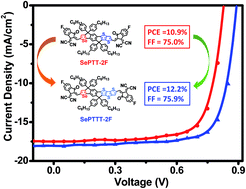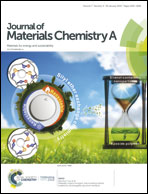Asymmetric selenophene-based non-fullerene acceptors for high-performance organic solar cells†
Abstract
Compared to thiophene-based non-fullerene acceptors (NFAs), selenophene-based NFAs have received much less attention. And organic solar cells (OSCs) based on selenophene-containing NFAs typically exhibit relatively low power conversion efficiency (PCE < 12%) and fill factor (FF < 70%). In this contribution, we have designed and synthesized two asymmetric selenophene-based NFAs, named SePTT-2F and SePTTT-2F, which possess the same end-capping group but different selenophene-containing conjugated backbones. On comparing the two NFAs, SePTTT-2F with more extended conjugation in the backbone was found to have almost the same maximum absorption peak and optical bandgap in film as SePTT-2F but an up-shifted lowest unoccupied molecular orbital (LUMO) energy level and higher electron mobility. By pairing the NFAs with the polymer donor PBT1-C, the resultant blend film based on SePTTT-2F exhibited higher and more balanced charge mobilities and more efficient exciton dissociation and charge collection in comparison with the SePTT-2F-based blend film. As a result, OSCs based on SePTTT-2F delivered an impressively high PCE of 12.24% with an outstanding FF of 75.9%, much higher than those of the SePTT-2F-based OSCs. To the best of our knowledge, the PCE of 12.24% and FF of 75.9% are among the highest values reported in the literature so far for both the parameters amongst selenophene-containing NFA-based OSCs. Our results demonstrate that extending the conjugation in the selenophene-containing backbone is an effective strategy to design highly efficient selenophene-based NFAs.



 Please wait while we load your content...
Please wait while we load your content...